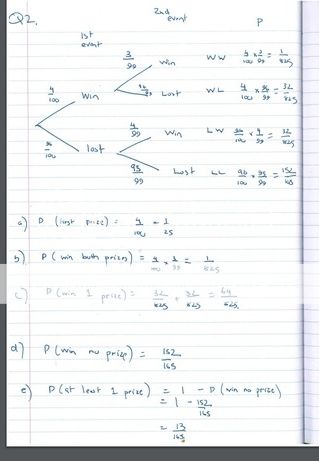Can someone please help me with these questions with working out?? The answers are there
Probability
1) a bag contains 3 yellow balls, 4 pink balls and 2 black balls. If the two balls are chosen at random, find the probability of getting a yellow and black ball.
a) with replacement
b) without replacement
answer: a) 4/27 b)1/6
2) Alan buys 4 tickets in a raffle in which 100 tickets are sold altogether. There are two prizes in a raffle. Find the probability that Alan will win
a) first prize
b) both prizes
c) 1 prize
d) no prize
e) attest 1 prize
answer:
a) 1/25
b)1/825
c)64/825
d) 152/165
e)13/165
3) Mary buys 20 tickets in a lottery that has 5000 tickets altogether. Find the probability that Mary will won
a) first and second prize
b) second prize only
c) neither first or second
answer:a) 19/ 1249750 b) 498/124975 c) 1239771/1249750
4) The two machines in a work shop each have a probability of 1/45 of breaking down. Find the probability that at any one time
a) neither machine ill be broken down
b) 1 machine will be broken down
5) A bag contains 5 black and 7 white marbles. Two are chosen at random from the bag
a) with replacement
b)without replacement
Find the probability of getting a black and a white marble
answer: a) 35/72 b)35/36
6) A card is chosen at random from a set of 10 cards numbered 1 to 10. A second card is chosen from a set of 20 cards numbered 1 to 20. Find the probability that the combination number these cards make is
a) 911
b)less than 100
c) between 300 and 500
Answer: a) 1/200 b) 81/200 c) 11/100
Probability
1) a bag contains 3 yellow balls, 4 pink balls and 2 black balls. If the two balls are chosen at random, find the probability of getting a yellow and black ball.
a) with replacement
b) without replacement
answer: a) 4/27 b)1/6
2) Alan buys 4 tickets in a raffle in which 100 tickets are sold altogether. There are two prizes in a raffle. Find the probability that Alan will win
a) first prize
b) both prizes
c) 1 prize
d) no prize
e) attest 1 prize
answer:
a) 1/25
b)1/825
c)64/825
d) 152/165
e)13/165
3) Mary buys 20 tickets in a lottery that has 5000 tickets altogether. Find the probability that Mary will won
a) first and second prize
b) second prize only
c) neither first or second
answer:a) 19/ 1249750 b) 498/124975 c) 1239771/1249750
4) The two machines in a work shop each have a probability of 1/45 of breaking down. Find the probability that at any one time
a) neither machine ill be broken down
b) 1 machine will be broken down
5) A bag contains 5 black and 7 white marbles. Two are chosen at random from the bag
a) with replacement
b)without replacement
Find the probability of getting a black and a white marble
answer: a) 35/72 b)35/36
6) A card is chosen at random from a set of 10 cards numbered 1 to 10. A second card is chosen from a set of 20 cards numbered 1 to 20. Find the probability that the combination number these cards make is
a) 911
b)less than 100
c) between 300 and 500
Answer: a) 1/200 b) 81/200 c) 11/100


